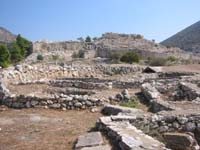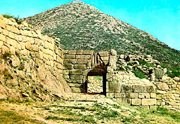THE MYCENAEN TREASURE
The acropolis reveals itself in the heart of the landscape that is barred to the north, a bit tamer towards the south. A gray mound of rock with the marks of the Cyclops upon it. One has to touch these gigantic rough – hewn in order to comprehend the deep sense of security they offered to the Mycenaen’s. Within these walls the leaders heaped the booty from their extended wars, gold and jewels, bowls and purple rugs.
Mycenae was the most powerful, brilliant and sovereign influence in Greece up to 1100 BC when it was destroyed by fire. Centuries later the tragic poets Aeschylus and Sophocles brought it back to life with the magic of their verses. One enters the Acropolis through the Lion Gate, the oldest example of monumental sculpture in Europe. A secondary entrance, built in the same style, exists in the north side. Inside the walls excavations have uncovered the palace complex, Grave Circle A with six royal tombs, courtiers’ houses, sanctuaries and other important buildings. Outside the acropolis lie the ruins of private houses. Grave Circle B with 14 royal tombs and 12 tombs of private citizens.
On the nearby hill of Panayitsa, archaeologists brought to light the most stunning edifice of Mycenaen architecture, the Treasure of Atreus, also known as the beehive tomb of Agamemnon. Most of the more exceptional findings from the site are on exhibition in the National Archaeological Museum in Athens. These include frescoes, gold jewellery, and the gold mask- which is said to have belonged to Agamemnon - among other priceless pieces.



